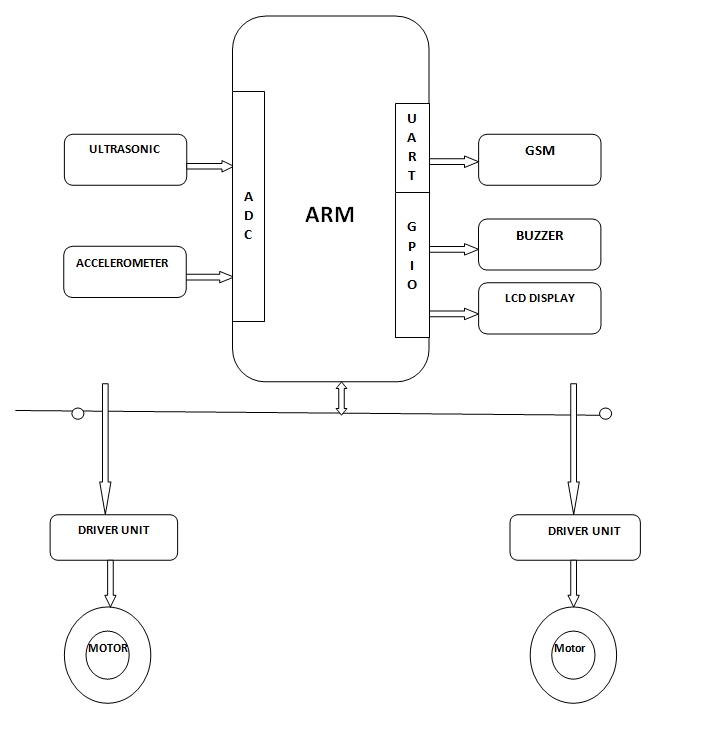
Real-Time Interaction with Smart Wheelchair using ARM
Call for Price
Real-Time Interaction with Smart Wheelchair using ARM
Description
ABSTRACT
Ubiquitous devices are becoming a part of people’s day-to-day life. Smart devices not only aid to people’s life but also are becoming a crucial part of physically challenged and aged people. The need for safe and independent mobility for the elderly and physical challenged people is of prime concern. The paper deals with creation of a Smart Wheel-Chair (SWC) that mainly focuses on the mentioned issue in a very affordable way and to a greater extent. The Wheel-Chair is controlled. It consists of a touch-screen based navigation system along with accident prevention and fall detection. A semi-automatic vision function and physiological stress sensors have been integrated. GPRS system is used for location determination and GSM is used to communicate in those cases where certain abnormal events like falling, accident or health issues are trigged. The real-time interaction functions are designed with the motive to make the user operating the wheel-chair completely self-dependent and his interaction with the environment can be like of a normal person.
EXISTING SYSTEM
- Manually controlling
- semi-automatic controlling
- RFID Tags based
PROPOSED SYSTEM
Smart Wheel-Chair (SWC) can be well navigated by a touch screen android device that could either be connected via USB or by Bluetooth configuration. Also with the help of GPS the exact location of the chair can be determined.
BLOCK DIAGRAM
BLOCK DIAGRAM EXPLANATION
The control system consists of a microcontroller embedded. When fall is detected GSM will inform. Breaking of motors when the obstacle is detected. This subsystem is responsible for detecting any moving/stationary objects within the specified range of the SWC with ultrasonic sensor. The fall detection subsystem is implemented with a MEMS accelerometer the accelerometer based fall detection is then connected to a GSM system.
HARDWARE REQUIREMENTS
- LPC2148
- Accelerometer
- Ultrasonic
- Motors
- Driver IC
- LCD
- Buzzer
- GSM
SOFTWARE REQUIREMENTS
- Keil
- Flash Magic
- Embedded C
REFERENCES
1. Simpson, R., LoPresti, E., Hayashi, S., Nourbakhsh, I., Miller, D.: The Smart Wheelchair Component System. Journal of Rehabilitation Research and Development 41, pp. 429–442 (2004)
2. Hamagami, T., Hirata, H.: Development of Intelligent Wheelchair Acquiring Autonomous, Cooperative, and Collaborative Behavior. In: IEEE International Conference on Systems, Man & Cybernetics, pp. 3525–3530 (2004)
3. Bourhis, G., Agostini, Y.: The VAHM Robotized Wheelchair: System Architecture and Human-Machine Interaction. Journal of Intelligent & Robotic Systems 22, pp. 39–50 (1998)
4. Bell, D.A., Borenstein, J., Levine, S.P., Koren, Y., Jaros, L.: An Assistive Navigation System for Wheelchairs Based Upon Mobile Robot Obstacle Avoidance. In: IEEE International Conference on Robotics and Automation, 2018-2022 (1994)
5. Lankenau, A., Rofer, T.: A Versatile and Safe Mobility Assistant. IEEE Robotics & Automation Magazine 8, pp. 29–37 (2001)
6. Borenstein, J., Koren, Y.: The Vector Field Histogram -Fast Obstacle Avoidance for Mobile Robots. IEEE Transactions on Robotics and Automation 7, pp. 278–288 (1991)
7. Borenstein, J., Koren, Y.: Obstacle Avoidance with Ultrasonic Sensors. IEEE Journal of Robotics and Automation 4, pp. 213–218 (1988)
Additional information
| Weight | 1.000000 kg |
|---|



Reviews
There are no reviews yet.